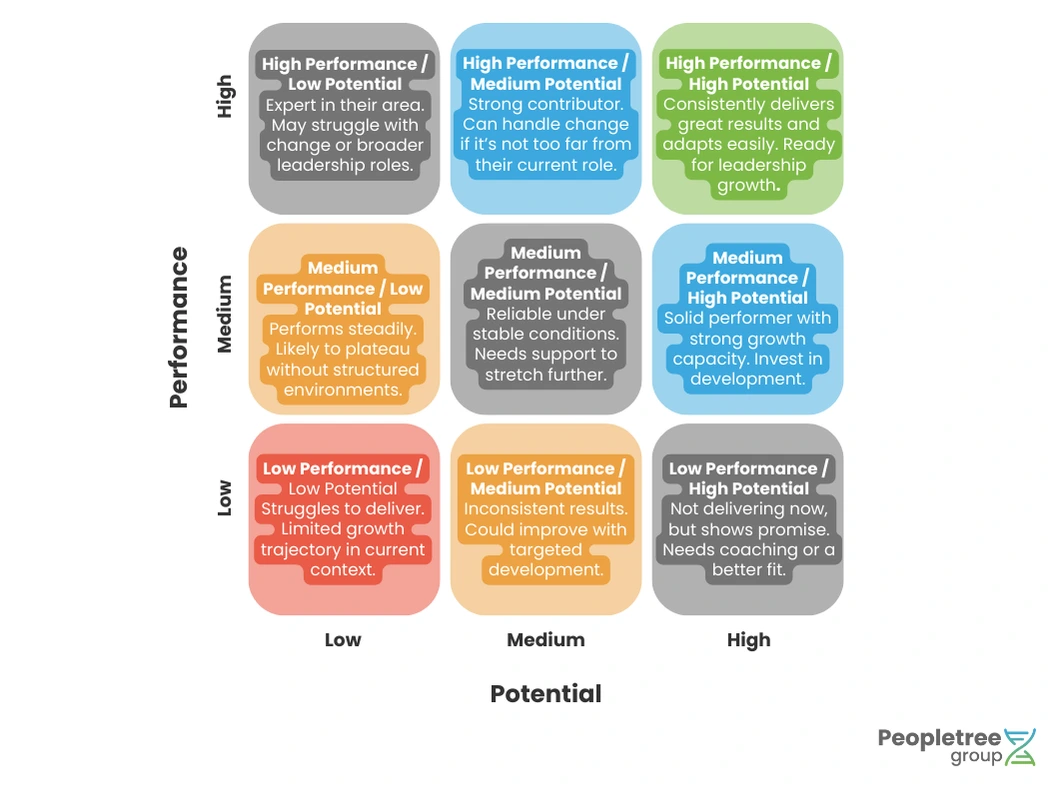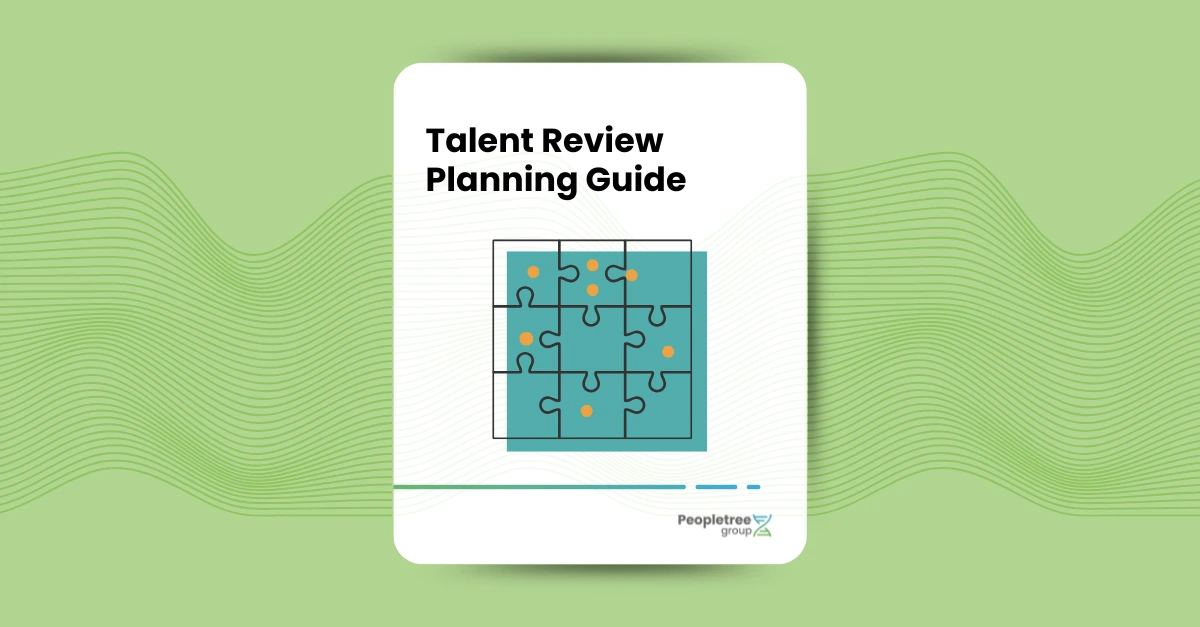May 6, 2025
Talent reviews are one of the most powerful ways to align your people with your profit strategy. But they often fail to deliver real value. Why? Because most businesses treat them as once-off rating exercises, not business-critical decision-making tools.
In this guide, we explain what a talent review process is, how it works, why it matters for mid-sized businesses, and how to overcome the biggest challenges.
What is a talent review, and why do you need one?
A talent review helps you see who’s ready to grow, who needs support, who’s ready to move—and who you can’t afford to lose. It gives business leaders and HR managers the clarity to focus time, money, and effort on developing, deploying, and retaining the people most likely to create future value.
Done well, it connects your people data to your business priorities. Done poorly, it becomes a biased discussion that undermines trust and leads to poor decisions.
For mid-sized businesses trying to grow fast without the luxury of a large HR team, a well-run talent review is your unfair advantage. It helps you:
- Identify top performers for business-critical roles
- Hold onto deep technical experts who keep things running
- Make sure the right people are in the right roles
- Focus development where it matters
- Catch poor performance early—before it damages teams or delivery.
What is the 9-box talent review method – and is there a better way?
The 9-box grid is one of the most commonly used tools in talent reviews. It maps performance on one axis and potential on the other to help you group employees and make calls about development, retention, or movement.
It’s a useful tool—if it’s used well.
But that’s where most teams get stuck. Without clear definitions, the right setup, and a process to guide the conversation, the grid can create more confusion than clarity.
Here’s what tends to go wrong—and how to fix it.

Common challenges to talent reviews, and how to fix them
Even with the best intentions, most talent reviews fall short. Here are six common challenges—and how a more structured, supported approach can solve them:
1. No real plan
Most businesses plan meticulously when it comes to finances, operations, and marketing. But when it comes to people? It’s often reactive, vague, or left too late.
Fix it:
Treat your people decisions like business decisions. Use the same rigour: clear goals, defined roles, structured inputs, and measurable outcomes. Talent reviews give you the data and structure to plan—not just hope.
What you need:
A repeatable talent review process that connects people data to business planning. That’s exactly what Talent Management as a Service (TMaaS) delivers. Read more about TMaaS here.
2. Poor data quality
The cornerstone of any successful talent review is high-quality data. This is the first and often most daunting challenge.
If you don’t have quality data, you will base your decisions on opinions that are changing, unreliable, and biased.
Fix it: Make it easy for managers to collect the right data, the right way. Build simple processes and tools that capture meaningful input—and make sure people know how to use them. Data quality improves when the system guides it.
What you need: A centralised system that standardises data inputs and supports managers with the right questions. This is built into Talent Management as a Service.
3. Opinion-led conversations
When there’s no shared understanding of “performance” or “potential,” conversations get personal. And inconsistent.
Fix it:
Use structured criteria and clear questions to anchor every conversation. With the right prompts and data points built in, even stretched managers can focus on what matters—not just who speaks loudest.
What you need:
A simple framework that embeds consistency into every talent conversation. TMaaS delivers this as part of the setup.
4. Confusing frameworks
The 9-box model seems simple—until you actually start using it. What do we mean by “performance”? Past performance? Current contribution? How far back do we go? And “potential” can mean promotability, future capability, or speed of progression—depending on who’s in the room.
Fix it:
Calibrate your framework. Define what performance means in your context—and do the same for potential. Are you measuring readiness to move, ability to grow, or both? Use structured criteria, clear questions and guide reviewers through the process with the right prompts.
What you need:
A well-defined, pre-configured model with built-in guidance and prompts. TMaaS delivers this from day one, making reviews easier to run—and easier to trust.
5. Bias and groupthink
People don’t always make great decisions in groups—especially when time is limited and the data isn’t clear. Loud voices dominate. Important details get missed.
Fix it:
Create space for better decisions. Spread reviews across multiple sessions, with pre-populated inputs that level the field. A good system encourages fairer conversations—without adding admin.
What you need:
A process designed to reduce bias—with structured inputs, scheduling, and support. TMaaS makes this easy to run.
6. The “Low Potential” label—and the over-focus on High Potentials
A High Potential moves faster than others. But it’s not only about speed. They also succeed in transitioning to the next level and they take on more complex work. But the hyper-focus on High Potentials in many businesses results in losing High Professionals.
A High Professional move steadily. They gain deep expertise, build long-term relationships and accumulate tons of knowledge along the way.
Too often, High Professionals (High Performing/Low Potential) are categorised as “Low Potentials”. We really dislike this term.
It’s demotivating, becomes a self-fulfilling prophecy and usually pushes people out. Ignoring them skews investment and leaves critical roles under-supported.
Fix it:
Reframe the conversation. A modern review process should recognise both High Potentials and High Professionals. High Potentials may move fast, but High Professionals go deep—and both are essential to growth and continuity.
What you need:
A talent framework that values depth as much as speed. TMaaS is designed to help you see the full spectrum of high-impact talent—not just the ones racing to the top.
7. No follow-through
If nothing changes after the review, people disengage. Managers stop seeing the value.
Fix it:
Build action into the process itself. The best reviews trigger the next steps—automatically feeding into development plans, retention actions, or workforce forecasts. A smart process doesn’t stop at the grid.
What you need:
A system that turns insights into action—automatically. TMaaS connects reviews directly to what happens next.
What does a great talent review process look like?
Talent reviews can create real value—but only if they’re planned, structured, and followed through. That starts with asking the right questions.
We’ve put together a practical planning guide to help you do just that. Whether you’re designing your process from scratch or tightening up what you already have, this is a simple way to get everyone aligned before the work begins.
Download the Talent Review Planning Guide
And if you’re looking for more than a guide—if you want the systems, structure and support to run talent reviews that actually drive growth—let’s talk.
Our talent review solution helped this client save 10, 000 hours per annum
- Eliminate Excel-based processes with a self-directed employee assessment and development tool
- Provides 360-degree feedback, performance management and personalised development plans
- Accurately identify the right talent for every role.








